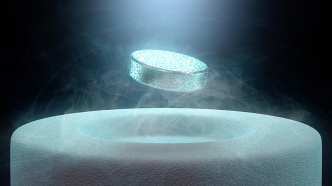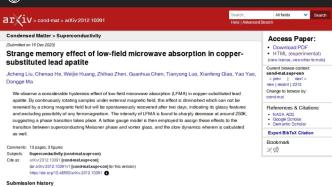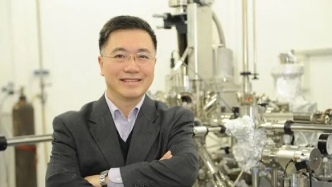
Less than two months after the first draft of the paper was posted on the preprint website arXiv, the work of the Nanjing University professor Wen Haihu's team to overthrow the research on room-temperature superconductivity in the United States was published online in the journal Nature on May 11, 2023.
Compared with the first draft of the preprint, the final published version provides more and more detailed data, demonstrating that there is no near-atmospheric room temperature superconductivity in the lutetium-hydrogen-nitrogen material. The data submitted at the time of the preprinted paper was that at pressures below 6 GPa, this nitrogen-doped lutetium hydride material does not have near-environmental superconductivity, that is, room-temperature superconductivity at normal pressure. A large amount of new data has been added to the newly published paper in the journal "Nature". Under the pressure of up to 40.1 GPa and as low as 2K, this material does not have superconductivity, let alone room temperature superconductivity under normal pressure. The so-called ambient superconductivity (ambient superconductivity).
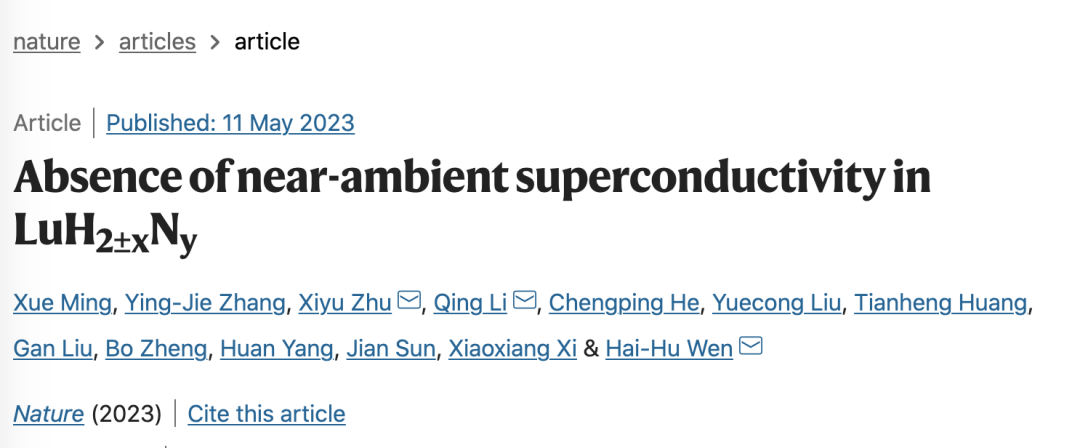
Screenshot of Nature website.
Just on March 8, the team of Ranga Dias from the University of Rochester in the United States published a study on room temperature superconductivity in "Nature", saying that a lutetium-hydrogen-nitrogen material developed by it has a temperature of nearly 10,000 Room temperature superconductivity has been achieved at atmospheric pressure (1GPa).
The publication of the Nature paper by Wen Haihu's team directly negates this conclusion. If the Dias team wants to maintain its conclusion of room-temperature superconductivity at near-atmospheric pressure, it must give convincing new evidence, "but it seems difficult," Wen Haihu said.
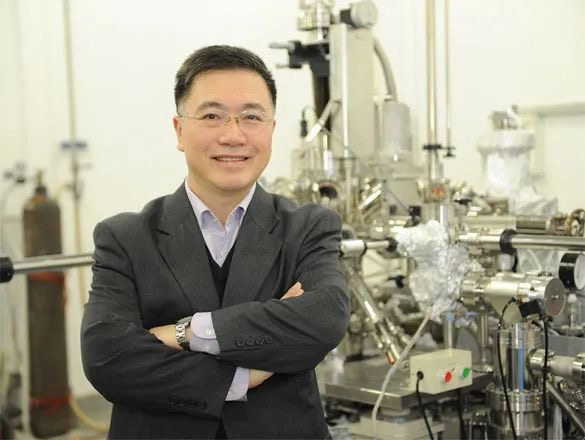
Source of Wen Haihu: Nanjing University
3 supplements
At the same time as the preprinted paper was released on March 15, Wen Haihu's team also contacted Nature to ask if they could publish research results that were contrary to the Dias team's conclusion. After receiving an affirmative answer, Wen Haihu submitted an article to Nature on the same day.
"Nature" magazine originally intended to publish this paper as a Matter Arising Argument (Conflicting Argument), but Wen Haihu's team added a lot of high-quality data in the process of replying to the review comments of the three reviewers. The content became rich and colorful, so after discussion with the editors of "Nature", it was finally decided to publish it in the form of a research paper.
Wen Haihu said: "It is more difficult to deny a study than to prove a study, because it needs to prove from multiple angles that the sample you are studying is almost the same as the sample under question. In addition, you need to use fine measurements and a large amount of data. and analysis to demonstrate."
Compared with the previous 16-page preprint paper, the "Nature" journal paper has much more data. Wen Haihu told "China Science Daily" that these supplements are mainly reflected in three aspects:
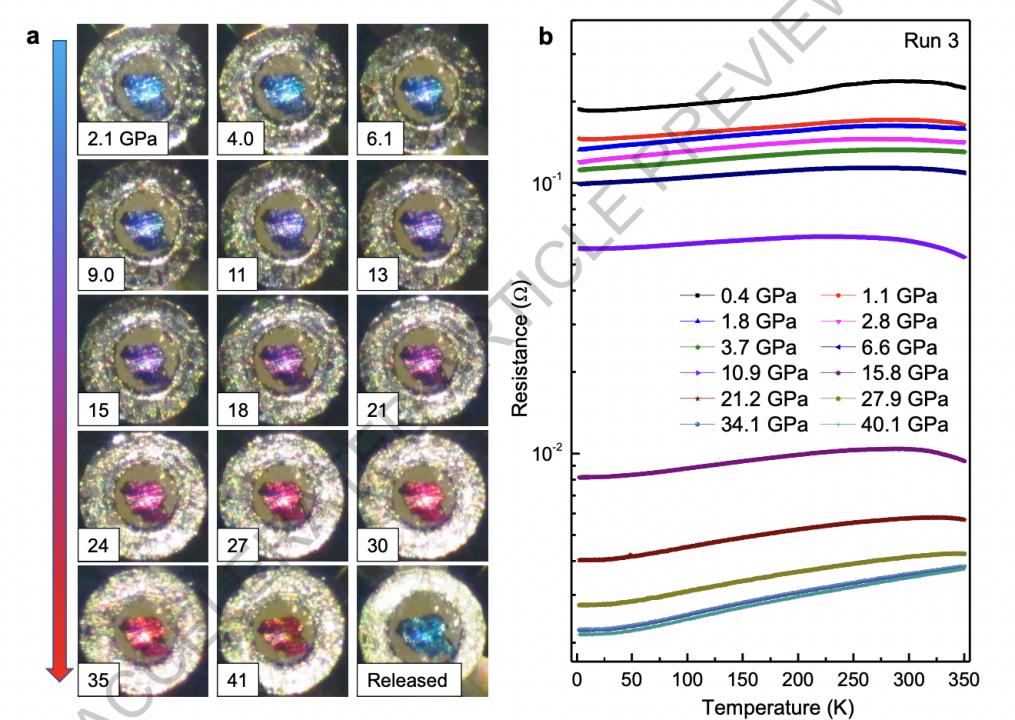
In the research of Wen Haihu's team, under different pressures, the sample has a gradient from dark blue, purple red to pink; and in all pressure and color states, the resistance also decreases with the decrease of temperature, but no super leading phenomenon.
First, more samples are required for testing. They have conducted experiments on more than 30 samples, and each experiment needs to be repeated. The new data includes the color evolution of the sample at a higher pressure, which is the above picture in the paper. It can be seen that under different pressures, the sample has a gradient from dark blue, purple red to pink; and in all pressure and color states, the resistance also decreases with decreasing temperature, but no superconducting phenomenon occurs.
Second, it needs to prove more rigorously that its experimental samples are consistent with Dias' experimental samples. They did multiple sets of X-ray diffraction experiments. The reviewers suggest that the lattice constants for XRD differ slightly from Dias' parameters. Wen Haihu said that the difference is actually very small, usually within the error range of the instrument. However, they re-conducted multiple rounds of experiments and made statistical averages. At the same time, they also measured Raman spectroscopy data, which can give detailed information on molecular vibrations, and it turned out that their samples were almost identical to Dias' samples.
Third, there is a need for comparison. The reviewer suggested that the possible superconductivity could not be measured because the experimental equipment was not sensitive enough? Therefore, Wen Haihu's team chose a copper oxide superconductor (transition temperature of 112K) that his team has worked for many years to perform the measurement under the same conditions: if the experimental lutetium-hydrogen-nitrogen material is superconducting, then its magnetic measurement signal should be Just as strong. However, the lutetium-hydrogen-nitrogen material signal is about 100 times weaker than that of a real superconductor, and the sign is positive, completely inconsistent with the behavior of a superconductor.
Compared with the preprint paper, another obvious difference of the "Nature" paper is that there are 5 more authors, mainly because new cooperation is required to supplement some new data. However, the number of texts in the main text is still a little less, because the expression is more rigorous and clear.
Wen Haihu said, "Our data is very rich and comprehensive, and beautiful, which can be described with a beautiful word."
Compete on the same stage
The publication of such a paper is also a duel of masters. For the controversial research published by "Nature", it is natural that "Nature" should be used as the platform for the confrontation.
In fact, in the past two months, in addition to the preprint studies published by the researcher Jin Changqing and Cheng Jinguang of the Institute of Physics of the Chinese Academy of Sciences on March 9 and March 12, respectively, as reported by the Chinese Journal of Science, the Qufu division The joint research of Daiwa Southeast University, and the team of Sun Liling, a researcher at the Institute of Physics of the Chinese Academy of Sciences, also published research on lutetium hydride, which also negated Dias' conclusion in a certain sense.
According to Wen Haihu, after "Nature" magazine also showed its manuscript to Dias, the latter gave feedback that the two samples were not completely consistent. However, in actual condensed matter physics experiments, it is difficult to say that absolutely identical samples can be produced.
Wen Haihu said that he hopes that the work of his team can play a role in eliminating the false and preserving the true. This is also a necessary process for scientific progress, especially for very important conclusions that need to be verified by other independent groups. He hopes that these works will warm up the atmosphere of room temperature superconductivity research, which will promote the research of metal hydrogen superconducting materials.
He believes that, from a physical logic point of view, room temperature superconductivity is not necessarily impossible to achieve. In this sense, the world's top scientists competing on the same stage will promote the rapid advancement of work in this area.
